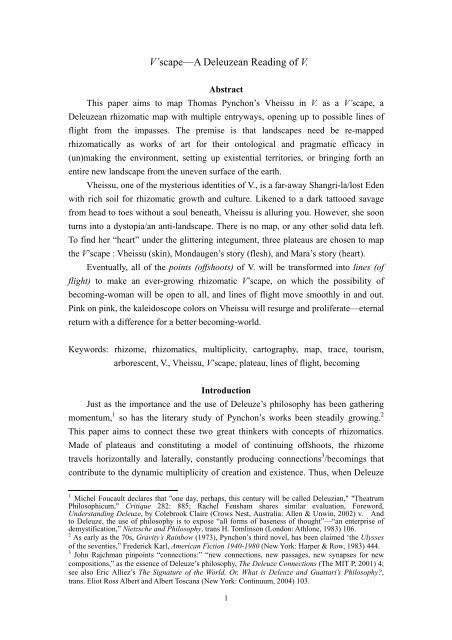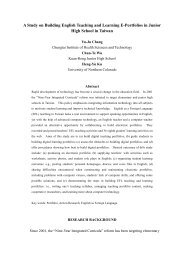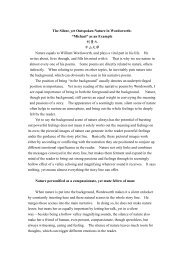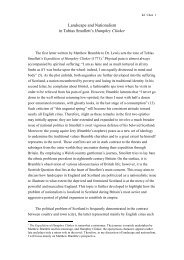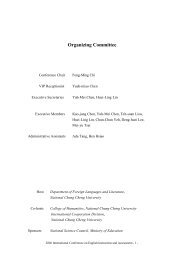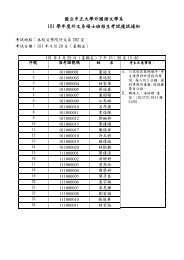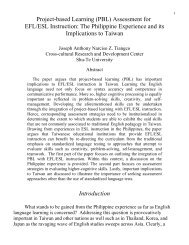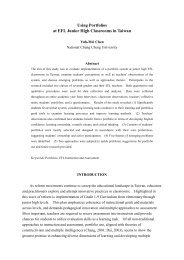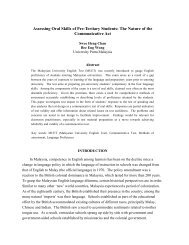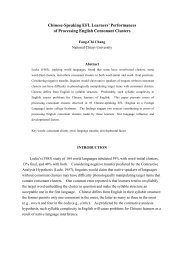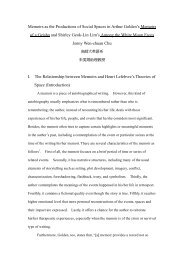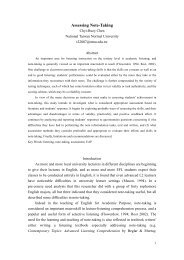V'scape?A Deleuzean Reading of V.
V'scape?A Deleuzean Reading of V.
V'scape?A Deleuzean Reading of V.
You also want an ePaper? Increase the reach of your titles
YUMPU automatically turns print PDFs into web optimized ePapers that Google loves.
V’scape—A <strong>Deleuzean</strong> <strong>Reading</strong> <strong>of</strong> V.<br />
Abstract<br />
This paper aims to map Thomas Pynchon’s Vheissu in V. as a V’scape, a<br />
<strong>Deleuzean</strong> rhizomatic map with multiple entryways, opening up to possible lines <strong>of</strong><br />
flight from the impasses. The premise is that landscapes need be re-mapped<br />
rhizomatically as works <strong>of</strong> art for their ontological and pragmatic efficacy in<br />
(un)making the environment, setting up existential territories, or bringing forth an<br />
entire new landscape from the uneven surface <strong>of</strong> the earth.<br />
Vheissu, one <strong>of</strong> the mysterious identities <strong>of</strong> V., is a far-away Shangri-la/lost Eden<br />
with rich soil for rhizomatic growth and culture. Likened to a dark tattooed savage<br />
from head to toes without a soul beneath, Vheissu is alluring you. However, she soon<br />
turns into a dystopia/an anti-landscape. There is no map, or any other solid data left.<br />
To find her “heart” under the glittering integument, three plateaus are chosen to map<br />
the V’scape : Vheissu (skin), Mondaugen’s story (flesh), and Mara’s story (heart).<br />
Eventually, all <strong>of</strong> the points (<strong>of</strong>fshoots) <strong>of</strong> V. will be transformed into lines (<strong>of</strong><br />
flight) to make an ever-growing rhizomatic V’scape, on which the possibility <strong>of</strong><br />
becoming-woman will be open to all, and lines <strong>of</strong> flight move smoothly in and out.<br />
Pink on pink, the kaleidoscope colors on Vheissu will resurge and proliferate—eternal<br />
return with a difference for a better becoming-world.<br />
Keywords: rhizome, rhizomatics, multiplicity, cartography, map, trace, tourism,<br />
arborescent, V., Vheissu, V’scape, plateau, lines <strong>of</strong> flight, becoming<br />
Introduction<br />
Just as the importance and the use <strong>of</strong> Deleuze’s philosophy has been gathering<br />
momentum, 1 so has the literary study <strong>of</strong> Pynchon’s works been steadily growing. 2<br />
This paper aims to connect these two great thinkers with concepts <strong>of</strong> rhizomatics.<br />
Made <strong>of</strong> plateaus and constituting a model <strong>of</strong> continuing <strong>of</strong>fshoots, the rhizome<br />
travels horizontally and laterally, constantly producing connections 3 /becomings that<br />
contribute to the dynamic multiplicity <strong>of</strong> creation and existence. Thus, when Deleuze<br />
1 Michel Foucault declares that "one day, perhaps, this century will be called Deleuzian," "Theatrum<br />
Philosophicum," Critique 282: 885; Rachel Fensham shares similar evaluation, Foreword,<br />
Understanding Deleuze, by Colebrook Claire (Crows Nest, Australia: Allen & Unwin, 2002) v. And<br />
to Deleuze, the use <strong>of</strong> philosophy is to expose “all forms <strong>of</strong> baseness <strong>of</strong> thought”—“an enterprise <strong>of</strong><br />
demystification,” Nietzsche and Philosophy, trans H. Tomlinson (London: Athlone, 1983) 106.<br />
2 As early as the 70s, Gravity’s Rainbow (1973), Pynchon’s third novel, has been claimed ‘the Ulysses<br />
<strong>of</strong> the seventies,” Frederick Karl, American Fiction 1940-1980 (New York: Harper & Row, 1983) 444.<br />
3 John Rajchman pinpoints “connections:” “new connections, new passages, new synapses for new<br />
compositions,” as the essence <strong>of</strong> Deleuze’s philosophy, The Deleuze Connections (The MIT P, 2001) 4;<br />
see also Eric Alliez’s The Signature <strong>of</strong> the World, Or, What is Deleuze and Guattari’s Philosophy?,<br />
trans. Eliot Ross Albert and Albert Toscana (New York: Continuum, 2004) 103.<br />
1
meets Pynchon, the seemingly random/unconnected points (which Pynchon is famous<br />
for) will be rhizomatically linked, creating new and dynamic concepts. 4 So, let’s start<br />
from the beginning--actually it’s already the middle, 5 the “excluded middle” 6 --to form<br />
a rhizome like “the orchid and the wasp”/“the partridge and the pear tree,”<br />
exemplifying the symbiotic nature <strong>of</strong> rhizomatic growth. 7<br />
A drawing is an act <strong>of</strong> creation, drawn ideally with the spirit <strong>of</strong> “the Pink<br />
Panther,” imitating nothing, reproducing nothing, painting the world its color, “pink<br />
on pink” (TP 11). Both V. and A Thousand Plateaus begin with a drawing/an epigraph,<br />
which provides interesting comparison. Let’s first take a look at the drawing <strong>of</strong> V.<br />
fractal, 8 A or a simulacrum <strong>of</strong> an isosceles triangle/inverted pyramid, made up <strong>of</strong> 8<br />
rows <strong>of</strong> the letter V (1, 2, 3, 4, 5, 7, 9, 11, respectively from the bottom to the top row)<br />
appears on the first page <strong>of</strong> V., which consists <strong>of</strong> 16 chapters plus one epilogue, the<br />
arrangement corresponding to that <strong>of</strong> A Thousand Plateaus, 15 sections/plateaus.<br />
We notice that all <strong>of</strong> the V’s are identical, duplicating in a cloning manner, by which<br />
Herbert Stencil weaves the genealogy <strong>of</strong> V. into a gigantic arborescent tree, fruit <strong>of</strong><br />
4 For more details <strong>of</strong> creating new concepts as the role <strong>of</strong> philosophy, see Deleuze Gilles and Felix<br />
Guattari’s final collaboration, What is philosophy?, trans. Graham Burchell and Hugh Tomlinson (New<br />
York: Verso, 1994).<br />
5 A rhizome “is always in the middle, between things, interbeing, intermezzo,” Gilles Deleuze and Felix<br />
Guattari, A Thousand Plateaus: Capitalism and Schizophrenia (Minneapolis: U <strong>of</strong> Minneapolis P, 1987)<br />
25, subsequently cited as TP.<br />
6 As Moly Hite points out, the philosophical principle/law <strong>of</strong> excluded middle: “Everything must either<br />
be or not be,” is much ridiculed in Pynchon’s works; in contrast, “including middle,” a concept<br />
corresponding to Deleuze and Guattari’s logic <strong>of</strong> “AND” (TP 25) would be more appropriate, Ideas <strong>of</strong><br />
Order in the Novels <strong>of</strong> Thomas Pynchon (Coloumbus: Ohio State UP, 1983).<br />
7 “The orchid and the wasp” is a trope used in A Thousand Plateaus (10), while “the partridge and the<br />
pear tree” appears in Thomas Pyncjon’s V. (London: Pan Book, 1975) 282, subsequently cited as V.<br />
8 “Fractal cartography” is a constantly repeated motif in Pynchon’s fiction, and the drawing <strong>of</strong> “a<br />
symbolic fractalic ‘V’” at the very beginning anticipates “a systematic pattern as symbolic<br />
announcement <strong>of</strong> our human insistence on drawing patterns to interpret reality” lies hidden below the<br />
“apparent narrative chaos,” Francisco Collado-Rodrigueza, “Trespassing Limits: Pynchon’s Irony and<br />
the Law <strong>of</strong> the Excluded Middle,” Oklahoma City U Law Review 24.3 (1999). Online posting. 20 Aug.<br />
2007 <br />
2
“stencilization,” 9 whose root is European colonialism/imperialism. Then, the first<br />
drawing on A Thousand Plateaus: it’s a piece <strong>of</strong> musical work. Distinctly different<br />
from the piling up <strong>of</strong> V’s, or normal musical notes, what we see is two types <strong>of</strong> lines:<br />
first, the original horizontal parallel lines <strong>of</strong> the staff pulled and stretched to form<br />
shapes <strong>of</strong> various asymmetrical “V”; second, entangled/entwined lines forming<br />
something like a surrealist decal, which may look like a map <strong>of</strong> Africa here, a female<br />
face/body there and what not—it’s a rhizomatic V., shooting up <strong>of</strong>fshoots at<br />
random--all because the musical points have been transformed into lines (TP 8). Great<br />
music, according to Deleuze and Guattari, “has always sent out lines <strong>of</strong> flight, 10 like<br />
so many ‘transformational multiplicities,’ even overturning the very codes that<br />
structure or arborify it; that is why musical form, right down to its ruptures and<br />
proliferations, is comparable to a weed, a rhizome” (TP 11-12).<br />
Obviously, these two drawings are different: one develops from a point to a<br />
multiplicity<br />
<strong>of</strong> the same; the other extends from a line to multiplicities <strong>of</strong> difference.<br />
We may conclude that (Stencil’s) V-diagram represents the “infinitely reproductive<br />
principles <strong>of</strong> tracing,” which “always comes back ‘to the same’,” adding up “only to<br />
the recurrence <strong>of</strong> an initial and a few dead objects” as well as “[Stencil’s] own<br />
extermination,” while the piano piece, a rhizomatic/proliferating “map” <strong>of</strong> “multiple<br />
entryways,” is “detachable, reversible, susceptible to constant modification” (TP 12;<br />
V 445, 451). Thus, to map the V’scape, rhizomatics/rhizoanalysis 11 will do the trick:<br />
all the “points” <strong>of</strong> V. could be assembled and extended into lines (<strong>of</strong> flight), just like<br />
the first V. symbol--“mercury-vapor lamps” shining and “receding in an asymmetric V<br />
to the east where it’s dark” (V 10). Eventually, all will rise up on the V’scape, and the<br />
arborified V. would be replaced by the rhizomatic V., 12 which will be “reinjected into<br />
still other lives, creating a fabric <strong>of</strong> heightened states between which the greatest<br />
number <strong>of</strong> connecting routes would exist.” 13<br />
heissu, 14 In V., the quest for the “real” meaning <strong>of</strong> V an exotically remote country<br />
9<br />
Shawn Smith regards Stencil as the text’s primary “historian,” attempting to solve the mystery <strong>of</strong> V. in<br />
endlessly multiplying interpretations in “the closed historiographic system,” “‘Truth or Falsity Don’t<br />
Apply’: V. and the Historiographic Method,” Pynchon and History: Metahistorical Rhetoric and<br />
Postmodern Narrative Form in the Novels <strong>of</strong> Thomas Pynchon, ed. William E. Cain (New York &<br />
London: Routledge, 2005) 19-58. Takashi Aso also points out “the monolithic Stencilian logic <strong>of</strong><br />
historical events” as the cause for Stencil’s failure in mapping V.’s history (17).<br />
10<br />
“Lines <strong>of</strong> flight” is an elusive term and Peter Fleming’s interpretation is close to the purpose here: it<br />
is “ a metaphor for everyday resistance,” dodging “subjectification, ” “‘Lines <strong>of</strong> Flight’: A History <strong>of</strong><br />
Resistance and the Thematic <strong>of</strong> Ethics, Death and Animality,” 2002 ephemera 2(3): 193-208.<br />
11<br />
The term is used by Charles Stivale while interviewing Guattari, The Two-Fold Thought <strong>of</strong> Deleuze<br />
and Guattari :Interactions and Animations (New York: The Guilford Press, 1998) 214.<br />
12<br />
Tamsin Lorraine uses the terms “arborescent connections” and “rhizomatic connections”<br />
to<br />
distinguish the difference between the the arborified stagnation and the rhizomatic growth, Irigaray<br />
and Deleuze: Experiments in Visceral Philosophy (London:Cornell UP,1999) 170.<br />
13<br />
Brian Massumi, Translator’s Foreword: Pleasures <strong>of</strong> Philosophy,” A Thousand Plateaus,<br />
xv.<br />
14<br />
Critical comments on the meaning <strong>of</strong> Vheissu are rather divergent/rhizomatic: 1.[Vheissu is] the<br />
subject <strong>of</strong> “international intrigue,” “an apocalyptic force, the negation beneath the surface <strong>of</strong><br />
3
and an emblem <strong>of</strong> the protean V, is desperately undertaken by Hugh Godolphin, and<br />
maniacally by Stencil; however, Vheissu refuses to yield up a fundamental referent.<br />
Instead, it accretes other V words, making V. an eponymous character—“Venezuela,”<br />
“Vesuvius,” “volcano,” “Victoria,” “Veronica (both the female rat 15 and a mysterious<br />
woman),” etc.—and as Stencil struggles to synthesize all <strong>of</strong> them, piling them up<br />
arborescently/genealogically, he is driven to construct an increasingly comprehensive<br />
plot, finally postulating that the Vheissuean are plotting to infiltrate and conquer<br />
Western civilization through the Antarctic subterranean network <strong>of</strong> natural tunnels.<br />
What Vheissu ultimately signifies is lost to Godolphin and Stencil. But with lines <strong>of</strong><br />
flight, the reader can re-map Vheissu with what happens on the plateaus <strong>of</strong><br />
“Mondaugen’s story” and “Mara’s story,” connecting them all to form the V’scape.<br />
Principle <strong>of</strong> cartography and decalcomania<br />
Cartography and decalcomania, two principles <strong>of</strong> rhizome, involve the practice<br />
<strong>of</strong> making maps and decals. The premise <strong>of</strong> cartography is that the world is<br />
measurable and that we can make reliable representations or models <strong>of</strong> that reality.<br />
For Deleuze and Guattari, the art <strong>of</strong> mapping is to avoid mere “tracing”--translating<br />
the map into an image; transforming the rhizome into roots and radicles; organizing,<br />
stabilizing, neutralizing the multiplicities on the basis <strong>of</strong> “the axes <strong>of</strong> significance and<br />
subjectification” (TP 13). Pynchon thinks likewise, and in V. he uses the terms like<br />
tourism/tourist/the Baedeker world/Baedeker land to express the tourist’s skin-deep<br />
“tracing” <strong>of</strong> foreign places; for example, after Evan, Godolphin’s son, tells what he<br />
knows about Vheissu to the Italian F.O., he is described thus: “in general he’d<br />
exhibited the honest concern and bewilderment <strong>of</strong> an English tourist confronted with a<br />
happening outside the ken <strong>of</strong> his Baedeker” (V 190). For the Baedekerland tourist, the<br />
landscape is “two dimensional” as only surface complexity and internal hollowness<br />
multiplicity” (Newman 54); 2. the private obsession <strong>of</strong> Godolphin, and a code name for Venezuela<br />
(Patteson 23); 3. a paradigm for the entire book V., representing “lost civilization” (New 100); 4. the<br />
“land <strong>of</strong> V.” because <strong>of</strong> its barbarity, color, femininity, and lack <strong>of</strong> soul (Fahy11); 5. linked to European<br />
imperialism, serving “as a metaphor, a symbol <strong>of</strong> the horror <strong>of</strong> Europe’s imperialist ambitions,” but<br />
also symbolizing “an ideal past” (Brownlie 26, 24); 6. prelapsarian beauty turning into “an Edenic<br />
wilderness and the estrangement <strong>of</strong> man from nature,” “a symbol for entropic decline” (Safers 92-93);<br />
7. “an inverted Eden,” “the Gnostic Garden <strong>of</strong> Evil,” and the insidious message: “V.’s you” (Eddins 65,<br />
67); 8. a region symbolizing “gaudy glamour dressing a void” (Stimpson); 9. a land <strong>of</strong> surfaces without<br />
heart or soul, lingering in the memory “as a play <strong>of</strong> shimmering, gaudy colors,” representing “the basic,<br />
apolitical nihilism,” “an emblem <strong>of</strong> life itself, colorful and diverse, but ultimately without substance”<br />
(Cowart 20, 21); 10. a weird fantasy land (Taner 44); 11. unappreciated “Shangri-la” by the British,<br />
responding “in sadistic terror to these glimpses <strong>of</strong> mystery” (Mackey 16, 17); 12. a land both fabulous<br />
and terrifying, a dystopia, its location vague, but its significance clear--the void and apocalyptic<br />
annihilation (Kharpertian 77, 78); 13. “accountability” replaced with the eulogizing <strong>of</strong> the vanquished,<br />
“the yearning and the imperialist nostalgia” (Kaplan 34); 14. “acts <strong>of</strong> sexual and geopolitical<br />
domination” yoked, “exposing as pathological desire to mark, cover, and own various kinds <strong>of</strong> space”<br />
(Russell 63); 15. humanized, dehumanized and reduced to a heap <strong>of</strong> garbage (Russell 64)—all <strong>of</strong> these<br />
can be treated with different hues as the <strong>of</strong>fshoots on the V’scape.<br />
15 It’s interesting to mention in passing that while rats, swarming over each other, are considered<br />
rhizomes in A Thousand Plateaus (6), in V. rats proliferate to such an extent that “American would<br />
belong to the rats,” and Veronica, a female rat converted to Christianity might even be canonized (118).<br />
4
upon the Other is projected, and the desire to see the world is merely to caress “the<br />
skin <strong>of</strong> each alien place,” or, akin to the power fantasies <strong>of</strong> the colonialist, to flay the<br />
“glittering integument” from “the barbarous body <strong>of</strong> the exotic Other” (V 409, 184;<br />
Mackey 18).<br />
Different from tracing/tourist map, the rhizomatic map can be “torn, reversed,<br />
adapted<br />
to any kind <strong>of</strong> mounting, reworked by an individual, group, or social<br />
formation”--a root-free living art (TP 12). Truly, maps provide much information<br />
about the past, including the philosophy and cultural basis <strong>of</strong> the map; however, maps<br />
are never realistic representations <strong>of</strong> the actual world, but estimations, generalizations,<br />
and interpretations <strong>of</strong> true geographic conditions. In Graham Huggan’s view, the<br />
contact between cartography and colonialism has much to do with “the procedures,<br />
and implications, <strong>of</strong> mimetic representation,” which “not only conforms to a<br />
particular version <strong>of</strong> the world but to a version specifically designed to empower its<br />
makers,” and “the apparent coherence <strong>of</strong> cartographic discourse is historically<br />
associated with the desire to stabilize the foundations <strong>of</strong> a self-privileging Western<br />
Culture” (125, 127). Thus, “cartographic discourse” can play an exemplary role<br />
demonstrating the empowering strategies <strong>of</strong> colonist rhetoric and the deficiencies <strong>of</strong><br />
these strategies so that “a link between a de/reconstructive reading <strong>of</strong> maps and a<br />
revisioning <strong>of</strong> the history <strong>of</strong> European colonialism” can be connected (Huggan 130).<br />
Deleuze and Guattari’s concept <strong>of</strong> the map opens up a “new space” for<br />
post- colonial writing and a useful working model for the description <strong>of</strong> post-colonial<br />
cultures and for the closer investigation <strong>of</strong> the kaleidoscopic variations <strong>of</strong><br />
post-colonial discourse, 16 including the possibility <strong>of</strong> “a feminist cartography”<br />
17 —“‘new territories’ outlawed or neglected by dominant discourses which previously<br />
operated in the colonial, but continuing to operate in modified or transposed forms in<br />
the post-colonial, culture” (Huggan 133).<br />
In a nutshell, the role <strong>of</strong> cartography<br />
in contemporary writing is to put<br />
“cartographic<br />
connection” to work, implementing a series <strong>of</strong> creative revisions<br />
registering the transition from a colonial framework within which the restrictions <strong>of</strong><br />
colonial space are reflected and recreated to a post-colonial one within which a series<br />
<strong>of</strong> “territorial disputes” and “a (re)engagement in the ongoing process <strong>of</strong> cultural<br />
decolonization” are engaged (by the writer) “in the pursuit <strong>of</strong> social and cultural<br />
16 Fascinated with the map, post-colonial writers <strong>of</strong>ten response both to physical (geographical) maps,<br />
having operated effectively, but <strong>of</strong>ten restrictively or coercively, in the implementation <strong>of</strong> colonial<br />
policy, and to conceptual (metaphorical) maps perceived to operate as exemplars <strong>of</strong>, and therefore to<br />
provide a framework for the critique <strong>of</strong>, colonial discourse (Huggan 125).<br />
17 A number <strong>of</strong> contemporary women writers have adapted Deleuze and Guattari’s model to the<br />
articulation <strong>of</strong> “a feminist cartography,” which dissociates itself from the “oversignifying” spaces <strong>of</strong><br />
patriarchal representation through the “deterritorizing lines <strong>of</strong> flight” to produce “an alternative kind <strong>of</strong><br />
map characterized not by the containment or regimentation <strong>of</strong> space but by a series <strong>of</strong> centrifugal<br />
displacements” (Huggan 132).<br />
5
change” (Huggan 134). Furthermore, recent understanding <strong>of</strong> the human ecosystems<br />
has led to a link between the notion <strong>of</strong> sustainability and harmonization <strong>of</strong> cultural<br />
and biological evolution, rendering the producing <strong>of</strong> the rhizomatic map with its<br />
multi-entryways for productive outgrows a new kind <strong>of</strong> cartography in need. 18<br />
Plateau 1: Vheissu—the Skin<br />
Hugh Godolphin, the Antarctic explorer and a British Empire<br />
hero, is the original<br />
teller <strong>of</strong> Vheissu, weaving the first line <strong>of</strong> its becoming. In 1884, he escorted a crew<br />
<strong>of</strong> civilian engineers (altogether 13 men) to Vheissu to do “contour lines and<br />
fathom-markings, cross-hatchings and colors where before there were only blank<br />
spaces on the map”—“All for the Empire” (172). Fifteen years later in Florence, like<br />
“the Ancient Mariner,” he eagerly/repentantly told Victoria Wren, the first avatar <strong>of</strong> V.,<br />
things about Vheissu. First, he told her how, through a series <strong>of</strong> (anti-)landscape,<br />
they managed to get to Vheissu: on camel-back over a vast tundra; past the dolmens<br />
and temples <strong>of</strong> dead cities; crossing a sun-forsaken broad river, being so thickly<br />
ro<strong>of</strong>ed with foliage; traveling in long teak boats carved like dragons and paddled by<br />
brown men speaking incomprehensible language; over a neck <strong>of</strong> treacherous<br />
swampland; across a green lake to come to the first foothills <strong>of</strong> the mountains which<br />
rang Vheissu. Here, native guides left them, and it took two more weeks or so over<br />
moraine, sheer granite and hard blue ice before the borders <strong>of</strong> Vheissu were reached. 19<br />
On arrival at Vheissu, Godolphin was fascinated by the gorgeous colors. Next<br />
wonder<br />
was the iridescent spider monkeys, changing colors in the sunlight. Not just<br />
that, everything from the mountains to the lowlands changed its color from one hour<br />
to the next; it was as if “you lived inside a madman’s kaleidoscope,” and even “your<br />
dreams become flooded with colors, with shapes no Occidental ever saw” (170). In<br />
retrospect, Godolphin likened Vheissu to “a dark woman tattooed from head to toes” 20<br />
and bore a wishful thinking <strong>of</strong> collecting himself “a harem <strong>of</strong> dusky native women”<br />
(170). However, he soon discovered her skin, “the gaudy godawful riot <strong>of</strong> pattern<br />
and color” was too much for him and in only a matter <strong>of</strong> days, he would pray to God<br />
not only “to send some leprosy to her,” but to “flay that tattooing to a heap <strong>of</strong> red,<br />
purple and green debris, leaving the vein and ligaments raw and quivering and open at<br />
last to your eyes and your touch” (171). The sudden twist from intoxicating love to<br />
maddening hatred was a puzzle. Vheissu simply became a restless place <strong>of</strong> “barbarity,<br />
insurrection, internecine feud,” probably due to the fact that the English “have been<br />
18 In “The Historical Roots <strong>of</strong> Our Ecological Crisis,” Lynn White proposes another alternative--a<br />
“religious” solution--for solving the worsening ecological crisis, which, in my opinion, is almost<br />
unattainable, The Ecocriticism Reader: Landmarks in Literary Ecology, ed. Cheryll Glotfelty and<br />
Harold Fromm (Athens: The U <strong>of</strong> Georgia P, 1996) 3-14.<br />
19 Deborah L. Madsen compared Godolphin’s travel to Vheissu with Dante’s travel down into Hell, The<br />
Postmodernist Allegories <strong>of</strong> Thomas Pynchon (Leicester, London: Leicester UP, 1991).<br />
20 It is a truism to traditionally construct nature as feminine, but with “dark” and “tattoo” added to the<br />
body map, the connotation apparently multiplies.<br />
6
jaunting in and out <strong>of</strong> places like Vheissu for centuries” (170). 21 Later, Evan,<br />
recollecting what his father had told him as bedtime story, supplemented some more<br />
details about Vheissu: human sacrifice, bathing with opalescent and fire-color fish<br />
dancing around, cities inside volcanoes that erupted into flaming hell, blue-faced men<br />
and women giving birth to sets <strong>of</strong> triplets only, and beggars belonging to guilds and<br />
holding jolly festivals all summer long. The story fabricated by his father was so<br />
incredible that Evan ceased believing in it years ago until now seeing English and<br />
Italian governments “hagridden to alienation over this fairy tale or obsession” (193).<br />
So, Vheissu’s lingering presence continues to be felt with much apprehension.<br />
The whole surveying expedition led by Godolphin ends with only three escaping<br />
narrowly:<br />
Godolphin, his second-command “incurable and insensate” in a hospital<br />
now, and a civilian who has “dropped out <strong>of</strong> human sight” (V 183). No maps <strong>of</strong><br />
Vheissu are made, only a report <strong>of</strong> failure and a line mentioning it in Godolphin’s<br />
dossier kept in a secret F.O. memorandum condensed from “Godolphin’s personal<br />
testimony” (190). What really happened in Vheissu is never clearly told by<br />
Godolphin. We only know there was no second expedition as it was considered too<br />
much <strong>of</strong> a luxury. Vheissu was simply “a bad country” and “it was all hushed up”<br />
(172). We have to wait fourteen years later when Godolphin reaches the South Pole.<br />
In 1898, Godolphin ventured into the Antarctic to find the truth about the “heart”<br />
<strong>of</strong> Vheissu.<br />
Considering himself a true explorer and distinguishes himself from the<br />
Baedekerland tourists who want only “the skin <strong>of</strong> a place,” he “wants its heart” (V<br />
204). What he finds at the South Pole is revealed to his friend Mantissa, who,<br />
idolizing Venus as his Goddess, is plotting to steal Botticelli’s “Birth <strong>of</strong> Venus” (hung<br />
at the west wall at the Uffizi Gallery) with a hollow Judas tree. 22 And the truth <strong>of</strong><br />
Vheissu is: “Nothing” (204). This epiphany dawned on Godolphin when he began to<br />
dig a cache at the South Pole after planting the flag (a sign for the sovereignty <strong>of</strong> the<br />
British Empire), and there it was: “Staring up at me through the ice, perfectly<br />
preserved, its fur still rainbow-colors, was the corpse <strong>of</strong> one <strong>of</strong> their spider<br />
monkeys”—“a mockery <strong>of</strong> life, planted where everything but Hugh Godolphin was<br />
inanimate” (205-6). Believing that it was the doing <strong>of</strong> the Vheissuean, who, fearing<br />
that Godolphin might reveal the secret <strong>of</strong> Vheissu to the outside world, had been after<br />
him slinkingly ever since he left Vheissu, Godolphin lamented: “If Eden was the<br />
creation <strong>of</strong> God, God only knows what evil created Vheissu. . . . a dream <strong>of</strong><br />
annihilation” (206). 23 What Godolphin fails to delve is the pr<strong>of</strong>ound but simple truth:<br />
21<br />
Dwight Eddins holds a different view thinking the “provenance <strong>of</strong> Vheissu is the most explicitly<br />
gnostic <strong>of</strong> any symbol” in V. and that only Satan with the demiurgic forces is capable <strong>of</strong> creating his<br />
own Garden like Vheissu with its madman’s colors and barbarous people (65).<br />
22<br />
Judas tree is said to be the one from which Judas Iscariot hanged himself after betraying Christ.<br />
23<br />
Josephine Hendin likens Godolphin’s trip to Vheissu to Kurts’s to Africa in Heart<br />
<strong>of</strong> Darkness in that<br />
he “went to Africa to civilize the natives and discovered the cannibal in himself, the need to murder<br />
the<br />
7
it is the (West/European/White) man who did this to Vheissu. 24 Mantissa somehow<br />
learns the lesson, and he gives up the larceny at the last moment—forming a line <strong>of</strong><br />
flight escaping “annihilation/nothingness/ontological void”--by saying affirmative<br />
“Yes,” to his partner Cesare’s protest, “You have come all this way, and now you will<br />
leave her?” (210). 25 However, it is still only Venus, hung at the “west” wall, the White<br />
Goddess, who is saved; the black/the marginalized/the preterite/the female<br />
represented by Vheissu are all still in dire situations. 26<br />
Still, we are left with the intriguing question: what on earth is Vheissu’s treasure?<br />
“Colors,<br />
music, fragrances” are what Godolphin remembers about Vheissu (204).<br />
How about ivory, diamond, uranium, gold, or other valuable minerals? Without<br />
solid evidence, it’s hard to nail down the exact answer; however, from Godolphin’s<br />
description, its splendid natural beauty and unique people may well be the key. If so,<br />
Vheissu’s “asset” is kept perhaps due to the fact that it’s far away and hard to reach<br />
(you have to pass through the valley <strong>of</strong> death) as well as that her people, that “feral<br />
and lunatic dominion cannot afford to let [Godolphin] escape,” wouldn’t be<br />
tamed/dominated without fighting back barbarously and forming their lines <strong>of</strong> flight--<br />
these may be the reasons why the British Empire finally decides to give Vheissu up,<br />
letting it remain the “blind” spot on the imperialist’s map (205). As to why Godolphin<br />
couldn’t let it be <strong>of</strong>f his memory, it is simply due to his nostalgic sentimentality <strong>of</strong> the<br />
Empire’s past glory. All he really cares about is “the glittering integument;” thus, he<br />
deliberately hides the “hard dead-point <strong>of</strong> truth” from “the lovers <strong>of</strong> skins”—“the<br />
same kind <strong>of</strong> truth” <strong>of</strong> every foreign land which “can be phrased in identical words”<br />
in all cases—even England’s (184). Not surprisingly, he can neither find the heart<br />
nor share it with others should he find the truth because he himself, representing the<br />
colonial sensibility, has no heart for the preterite.<br />
Thus, although there might indeed be some other<br />
treasures hidden somewhere in<br />
the kingdom<br />
<strong>of</strong> Vheissu besides the natural beauty, they are, in comparison, too<br />
insignificant to really matter. Once a rhizomatic landscape has turned into an<br />
arborified anti-landscape, be wary <strong>of</strong> the counterattack from Nature.<br />
So far, the story <strong>of</strong> Vheissu seems to be but another invasion <strong>of</strong> the British<br />
beauty whose sexual pull made him want to mutilate her,” and his fleeing to the South Pole made him<br />
realize he would “never escape the destructiveness in himself;” thus, he “embodies civilization’s<br />
crucial question: how to keep the monkey <strong>of</strong>f your back” (43); Molly Hite thinks so likewise (60).<br />
24 Based on imperial viewpoint, Godolphin’s “blindness” is shared by Sidney Stencil, who “maps”<br />
Valleta as an “aseptic administrative world,” “surrounded by an outlying vandal-country . . . ill-lit<br />
except for rendezvous points, which stand out like sequins [the <strong>of</strong>f-color Vheissu ] on an old and<br />
misused ball-gown” (V 468).<br />
25 Saying “NO” to the alluring surface and the void beneath it, Mantissa preserves himself and provides<br />
himself with a line <strong>of</strong> flight from subsequent sense <strong>of</strong> guilt and annihilation (Newman 55).<br />
26 See Hazel Carby’s “White woman listen! Black feminism and the boundaries <strong>of</strong> sisterhood,” for<br />
including black women’s experience in rewriting the narrative <strong>of</strong> “herstory,” The Empire Strikes Back:<br />
Race and Racism in 70s Britain (London: Hutchinson, 1982) 212-35.<br />
8
Empire. However, all that metaphorically pictured by Godolphin--his carnal and<br />
sadist<br />
desire (with the imperial and masculine pose) <strong>of</strong> flaying and deflowering<br />
Vheissu--will be materialized vividly in flesh in the next plateau, “Mondaugen’s<br />
story,” supported by stark historical facts/flesh, making the scenery on the V’scape<br />
more gruesomely “colorful.”<br />
Meroving, another avatar <strong>of</strong> V., to the old-age Godolphin in his seventies: “This siege.<br />
It’s<br />
The rational connection between the two plateaus is the remark made by Vera<br />
Vheissu. 27 It’s really happened,” to which Godolphin’s reaction is laughing,<br />
saying: “Vheissu was a luxury, an indulgence. We can no longer afford the likes <strong>of</strong><br />
Vheissu” (248). Because <strong>of</strong> the war, “our Vheissu are no longer our own, or even<br />
confined to a circle <strong>of</strong> friends; they’re public property . . . No more Vheissu,” and<br />
with that Godolphin erases his Vheissu from the surface <strong>of</strong> he earth (248, 249).<br />
Plateau 2: Mondaugen’s Story--the Flesh<br />
Tersely put, Deleuze's philosophical enterprise is to develop in new ways<br />
a<br />
commitment to an immanent ontology, stressing the importance <strong>of</strong><br />
the social and the<br />
political<br />
to the very heart <strong>of</strong> being, and affirming difference over the transcendental<br />
hierarchy in every aspect. The final comment made by Cesare after the aborted theft<br />
<strong>of</strong> Venus, “things and people can be found in places where they do not belong,” serves<br />
as a good starting point for Mondaugen’s story, in which the Germans’ intrusive<br />
presence, another colonial exploitation on the Dark Continent, is an even more<br />
fiendish nightmare that denies “the affirmation <strong>of</strong> difference” (V 212).<br />
Historically, western imperialism was a process by which only a few people<br />
within a few states, “took possession <strong>of</strong> much <strong>of</strong> the rest <strong>of</strong> the world and<br />
(re)named<br />
it;” at<br />
its height, in the late 19th and early 20th century, “much <strong>of</strong> the production <strong>of</strong><br />
the entire human race went to support and enrich those living in a few European<br />
countries” (Ivison 134). 28 Mondaugen’s story tells a tale <strong>of</strong> this kind. Here,<br />
Godolphin’s private fantasies based on Vheissu have been transformed into public<br />
realities <strong>of</strong> a most grisly sort, and the gaudy “dream <strong>of</strong> annihilation” associated with<br />
“iridescent” spider monkeys and Antarctic wastes is literally realized in this plateau<br />
heaped with native corpses “bejeweled green, white, black, iridescent with flies and<br />
their <strong>of</strong>fspring”(V 269). Eventually, the “might have been” “has finally happened.”<br />
Godolphin provides mostly “the skin” <strong>of</strong> Vheissu, and although he has<br />
desperately tried to find her “heart,” without “the flesh,” it all ends in vain. The<br />
27 Kerry Grant thinks the comment is made due to the association <strong>of</strong> the Bondel insurgents with the<br />
“barbaric and unknown race” <strong>of</strong> Vheissu, supposed by the intelligence services <strong>of</strong> Italy and Britain to<br />
be about to invade Europe via the network <strong>of</strong> tunnels beneath the Antarctic ice, A Companion to V.<br />
(Athend and London: The U <strong>of</strong> Georgia P, 2001) 129.<br />
28 Michael Harris’s “Pynchon’s Postcoloniality” has a through discussion <strong>of</strong> (post)colinialism in<br />
Pynchon’s novels, Thomas Pynchon: <strong>Reading</strong> from the Margins, ed. Niran Abbas (Cranbury, NJ:<br />
Associated UP, 2003) 199-214.<br />
9
line/ yarn is abruptly snapped with his “Nothing;” however, with the cue: “It’s Vheissu.<br />
It’s finally happened,” some connection can certainly be built with “Mondaugen’s<br />
story,” whose background is “Foppl’s Siege Party” in 1922. On this plateau, two<br />
historical uprisings <strong>of</strong> the African natives against the colonial domination are<br />
described, 1904’s massacre and 1922’s uprising, consequently generating two other<br />
“infamous trees,” impeding the rhizomatic growth/network (Massumi xiii).<br />
South-West Africa was the German colony, and German settlers were drawn to it<br />
by economic possibilities in diamond and copper mining, and especially<br />
farming.<br />
Due to all kinds <strong>of</strong> unnamable atrocities done to the native, on January12th, 1904, the<br />
Herero people rose in rebellion against the German colonial rule. In August German<br />
general Lothar von Trotha finally defeated the Herero. 29 When von Trotha was<br />
replaced due to a public outcry, it was too late to help the Herero, as the few survivors<br />
had been herded into camps, where many died <strong>of</strong> overwork, malnutrition or disease.<br />
In total, von Trotha’s extermination order resulted in the slaughter <strong>of</strong> fourth-fifths <strong>of</strong><br />
the Herero; 30 consequently, it has been called “the first genocide <strong>of</strong> the 20 th century,”<br />
and some historians draw a direct lineage between von Trotha’s plan for the<br />
extermination <strong>of</strong> the Herero and the holocaust sponsored by the government <strong>of</strong> Nazi<br />
Germany. Historically significant, in V. the native slaughter <strong>of</strong> 1904 is related to the<br />
extermination <strong>of</strong> the Jews—“This is only 1 percent <strong>of</strong> six million, but still pretty<br />
good” (V 245). And colonialism persists as a live issue into 1922 as there is a very<br />
strong continuity between the Herero’s uprising in 1904 and the Bondel’s revolt in<br />
1922 (Seed 95). 31 Ironically, Mondaugen and the other European settlers withdraw<br />
into Foppl’s villa. The whole event is presented through the innocent eyes <strong>of</strong> Kurt<br />
Mondaugen, whose “ignorance parallels that <strong>of</strong> the reader and the narrative partly<br />
enacts his and our learning <strong>of</strong> historical facts” (Seed 96). As if reflecting the dire<br />
human pathos, the landscape in Mondaugen’s narrative is <strong>of</strong> “sheer strangeness,” a<br />
“wasteland” with “huge spaces, strange light and proximity [to] the Kalahari (‘that<br />
vast death’),” making it “a positive threat” dwarfing the human figure—“a landscape<br />
29 Adrian Dietrich Lothar von Trotha, Commander in Chief <strong>of</strong> German South West Africa in 1904,<br />
issued orders to crush the native Herero rebellion by encircling them on three sides so that the only<br />
escape route was into the waterless Omaheke-Steppe, a western arm <strong>of</strong> the Kalahari Desert. The Herero<br />
fled into the desert and von Trotha had water holes poisoned, erected guard posts along a 150 mile line<br />
and shot on sight any Herero, be they man, woman, or child, who attempted to escape; hence, many<br />
dying <strong>of</strong> thirst. His Vernichtungsbefehl, or extermination order, was in marked distinction to that <strong>of</strong><br />
the Herero leaders, who were, in the main, careful to ensure that only German soldiers were attacked..<br />
30 Prior to the uprisings, there were estimated to be 80,000 Herero. In the 1911 census, 15,000 were<br />
found. Von Trotha’s troops also routed the Nama. On April 22, 1905, he sent a message to Nama,<br />
suggesting they surrender, and mentioning the fate <strong>of</strong> Herero. Eventually, approximately 10,000<br />
Nama died during the fighting, the remaining 9,000 were confined in concentration camps.<br />
31 After the massacre done by Trotha’s order, the survivors were gathered in concentration camps and<br />
put to hard labor. They hoped that they would receive better treatment under the Union, but they fared<br />
no better and in 1922 Abrahan Morris, the Bondelswaartz leader, returned illegally from exile and an<br />
attempt to arrest him led to a tribal uprising. The Union authorities massacred these rebels with<br />
machine guns and bombs dropping from aeroplanes “for the first time in history”(Seed 95).<br />
10
where death is constantly present and <strong>of</strong>fers an appropriate context to mass killing”<br />
(Seed 96). Without <strong>of</strong>fshoots <strong>of</strong> rhizomatic growth, lines <strong>of</strong> flight are arborified.<br />
A worshipper <strong>of</strong> von Trotha, Foppl attempts to re-create the ambience <strong>of</strong> 1904,<br />
forcing his guests to dress in accordance with the earlier period, addressing the native<br />
he is beating as a loving parent, 32 and watching the massacre <strong>of</strong> the natives from the<br />
villa as if it were a private entertainment. Surrounded by this kind <strong>of</strong> ambience,<br />
Mondaugen is involuntarily caught up in a common purpose as were the German<br />
soldiers <strong>of</strong> 1904. In his dream he re-creates the uprising <strong>of</strong> eighteen years earlier<br />
through the persona <strong>of</strong> an anonymous German cavalryman, 33 who follows von<br />
Trotha’s counsel, putting aside guilt and accountability for the forced labor, rape,<br />
mutilation, and random murder. With the colonizer’s superior status, he takes by<br />
force as his concubine a Herero girl named Sarah, who has been held in the thorn<br />
enclosures and whipped until her back is a “text” <strong>of</strong> scars (Weisenburger 150). He<br />
hides her in chain in his hut, not willing to share her with others. However, Sarah is<br />
found and gang raped. 34 She escapes afterward, but only to drown in the ocean<br />
nearby. The following day her body is washed up on the beach, with her breast half<br />
eaten by jackals, a scene not unusual as the entire coast is “actually littered each<br />
morning with a score <strong>of</strong> identical corpses” (273). 35 Witnessing such a gruesome scene,<br />
even nature ceases “becoming,”<br />
A sun with no shape, a beach alien as the moon’s Antarctic, restless<br />
concubines in barbed wire,<br />
salt mists, alkaline earth . . . the inertia <strong>of</strong> rock,<br />
the frailty <strong>of</strong> flesh, the structural unreliability <strong>of</strong> thorns, the unheard<br />
whimper <strong>of</strong> a dying woman; the frightening but necessary cry <strong>of</strong> the strand<br />
wolf in the fog. (274)<br />
32 Mondaugen witnesses how Foppl sadistically tortures a Bondel male, whose naked body is a map <strong>of</strong><br />
flesh sjamboked open like “so many toothless smiles,” with “the white vertebra” winking at him from<br />
one long opening [a realization <strong>of</strong> Godolphin’s sadistic desire <strong>of</strong> flaying Vheissu], while Foppl tells the<br />
Bondel to be joyful, sing hymns <strong>of</strong> thanks, and love him as his parent (V 240).<br />
33 Though the name is not clearly given, from the context I share with David Seed’s opinion,<br />
identifying the cavalryman as Foppl, the host <strong>of</strong> the party and the admirer and follower <strong>of</strong> von Trotha.<br />
34 In Dana Medora’s view, the gang rape <strong>of</strong> Sarah, “the pivotal scene <strong>of</strong> brutality in the novel,” takes<br />
“the horror <strong>of</strong> male domination even further,” and her death is “an act <strong>of</strong> refusal to be violated further<br />
or to yield her body, her labor, to the [concentration] camp’s enterprise” (22).<br />
35 The death <strong>of</strong> the young Herero woman derives from a book, which is basically a travelogue, South<br />
African Cinderella: A Trek through Ex-German Southwest Africa, by an Englishman named Rex<br />
Hardinge, in whose eyes Southwest Africa was a Cinderella-land <strong>of</strong> immense potential stifled by<br />
colonial mismanagement and apartheid, and he found solid pro<strong>of</strong> for all the cruelty described in<br />
V.--hangings, disembowelings, and the slow strangulation <strong>of</strong> victims by stringing them up between the<br />
v-shaped branch <strong>of</strong> a tree. One <strong>of</strong> Hardinge’s witnesses recalled that many <strong>of</strong> the young women held in<br />
the thorn enclosures and violated at random by the German men had attempted to escape by swimming,<br />
and their corpses were washed up on the beach. “One corpse,” the witness recalled, “was that <strong>of</strong> a<br />
young woman with practically fleshless limbs, whose breast had been eaten by jackals” (227). It was,<br />
as Mondaugen imagines it to be, evidently a common sight at the time. So, the “contours <strong>of</strong> history<br />
merging with the smallest folds <strong>of</strong> the fictional narrative: in V., during one <strong>of</strong> the more self-consciously<br />
fantastic portions <strong>of</strong> the narrative, a dream, the outlines <strong>of</strong> the episode are nonetheless verifiable as<br />
historical fact” (Weisenburger 151-52).<br />
11
Vividly, this<br />
catalogue “captures the non-humanized, alien nature <strong>of</strong> the landscape”<br />
(Seed 99). Thus, the “dream <strong>of</strong> annihilation” beneath the skin <strong>of</strong> Vheissu becomes the<br />
actual systematic annihilation <strong>of</strong> native tribes in South-West Africa, a “humanity’s<br />
defeat by the inhuman” (Patteson 25). From “an imagistic viewpoint,” the siege<br />
party’s “animated variant <strong>of</strong> the ‘iridescent’ Vheissu dream has degenerated into an<br />
African-coast variant <strong>of</strong> Antarctic bleakness and alienation, the wasteland in which<br />
Godolphin had experienced the final extension <strong>of</strong> Vheissu’s tentacles” (Eddins 70).<br />
(Seed 98). se<br />
36 Leaving the villa, he meets a kind Bondel (“a good Samaritan”) who<br />
families<br />
are all mercilessly killed but he gives Mondaugen a donkey ride. Mondaugen<br />
map <strong>of</strong><br />
Vheissu,<br />
devoid <strong>of</strong> humanistic concern, 37 we find Mondaugen’s story contains too<br />
and flicking his buttocks rhythmically with a sjambok. Vheissu is no longer<br />
his<br />
nightmare,<br />
but we haven’t forgotten the “soul” he has failed to find yet.<br />
On the V’scape, with lines <strong>of</strong> flight we jump from the plateau <strong>of</strong><br />
Vheissu, on<br />
which the gaudy skin eventually gets “wrinkled” through Godolphin’s<br />
“nightmares”<br />
and<br />
Significantly, Mondaugen “makes a gesture <strong>of</strong> rejection by leaving the villa”<br />
rests his face against the scarred back <strong>of</strong> the native, and “a minimal human contact” is<br />
established—a line <strong>of</strong> connection/flight created on the V’scape (Seed 99).<br />
With Mondaugen’s story, the map <strong>of</strong> German South-West Africa can surely be<br />
re-mapped anew with the “cartographic connection.” Unlike Godolphin’s<br />
much human pathos, which, with “the cartographic turn,” can be turned into a new<br />
space worthy <strong>of</strong> being “judged like works <strong>of</strong> art for their ontological and pragmatic<br />
efficacy in making and unmaking the environment, setting up existential territories, or<br />
bringing forth entire world from the uneven surface <strong>of</strong> the earth” (Bosteels 147).<br />
We last see Godolphin in Vera’s clothes, dancing about a Bondel’s hanging body<br />
Plateau 3: Mara’s Story--the Heart<br />
is “all there had ever been,” to the plateau on Foppl’s villa, on which<br />
massacre/genocide arborifies even nature’s growth/becoming, and now to another<br />
plateau on Malta, on which Vheissu’s heart/soul will finally be found and liberation <strong>of</strong><br />
female body complete (V 206).<br />
This time the connection is a talk between Sidney and Demivolt in which the<br />
name <strong>of</strong> Vheissu is mentioned. Twenty years ago (1899) in Florence when Vheissu<br />
became<br />
a live file again, they both worked to solve the riddle <strong>of</strong> Vheissu, which came<br />
to naught. Yet, even now “the Vheissu affair” is still anxiously remembered for likely<br />
36 Jimme Cain sees Foppl’s fortress as “closed systems,” and only Mondaugen “escapes the physically<br />
and spiritually debilitating fortress, Foppl’s haven <strong>of</strong> arrested time” (74, 76)<br />
37 Jessica Berman thinks there is a concerted effort <strong>of</strong> geographers to remake their discipline as a new<br />
science <strong>of</strong> ongoing human-landscape relations, and the essential key words in this new cultural<br />
geography were relationship and change, especially as applied to human existence in landscape over<br />
the long term, “Modernism’s Possible Geographies,” Geomodernisms: Race, Modernism, Modernity,<br />
ed. Laura Dlyle and Laura Winkiel ( Bloomington and Indianapolis: Indiana UP, 2005) 281-96.<br />
12
chaotic situation that none “wants to see lit into holocaust” (470, 194).<br />
The current status <strong>of</strong> Malta is that massacre has been predicted and “a<br />
Situation-in-the-process-<strong>of</strong>-becoming” is going on (470). 38 The unpleasant<br />
remembrance<br />
<strong>of</strong> Vheissu causes Sidney to lament, “Can’t Vheissu ever be a dead<br />
file?” to which Demivolt answers, “Call Vheissu a symptom. Symptoms like that are<br />
always alive, somewhere in the world” (473). It’s a symptom <strong>of</strong> a certain disease,<br />
whose name is not specified but can surely be inferred as the insatiable encroachment<br />
<strong>of</strong> colonialism/imperialism. Demivolt’s remark also rings a bell <strong>of</strong> Godolphin’s final<br />
remark on Vheissu’s becoming “public property,” and to deal with it, the soul is to be<br />
found through “Mara’s Story,” which will provide new rhizomatic connections.<br />
On Malta, “Island <strong>of</strong> sunshine,” Mehemet, an experienced master told Sidney<br />
Mara is “an inconstant goddess,” and “Be wary <strong>of</strong> her” (V 457). According to the<br />
legend,<br />
Mara is a historical personage (known for doing only good deeds, nursing the<br />
shipwrecked and teaching love to every invader) who turns into a saint, then a spirit<br />
living in Xaghriet Newwija, and Valletta (capital <strong>of</strong> Malta) is her domain. Early in<br />
1565, two privateers captured a Turkish galleon belonging to the chief eunuch <strong>of</strong> the<br />
Imperial Seraglio. In retaliation Mara was taken prisoner and brought back to<br />
Constantinople. On the way back, the Turks lashed Mara to the bowsprit and that was<br />
how she entered Constantinople: a living figurehead. On drawing near that city, she<br />
was heard to cry: “Night, so be it.” The Turks thought she was either raving or blind.<br />
Disguise was one <strong>of</strong> her attributes, and she’d always been attributed magical<br />
talents, “a quaint, hermaphrodite sort <strong>of</strong> deity,” which might “embarrass the<br />
Anglo-Saxon<br />
nerves” (V 462). Tall, slim, small eyes <strong>of</strong> wide spacing, small-breasted<br />
and bellied, she was not a beauty, but she was a good teacher <strong>of</strong> love. Having pleased<br />
the Sultan, she was installed as a concubine. Yet, once in the seraglio she raised hell.<br />
A few weeks after Mara entered the seraglio, the Sultan noticed a certain<br />
coldness infecting his nightly companions: “a reluctance, a lack <strong>of</strong> talent;” even the<br />
attitude<br />
among the eunuchs changes, a kind <strong>of</strong> “smug and keeping a bad secret <strong>of</strong> it”<br />
(463). To find out the truth, he had certain girls and eunuchs severely tortured, but<br />
all in vain. Shy concubines once pacing with ladylike steps—“limited by a slim<br />
chain between the ankles”—and downcast eyes were now smiling and flirting<br />
promiscuously with the eunuchs, who flirted back (463). Girls left to themselves<br />
38 Some historical facts <strong>of</strong> Malta might help develop our interest here. In 1814, Malta voluntarily<br />
became part <strong>of</strong> the British Empire. During World War II, Malta survived relentless raids from German<br />
and Italian military forces (1940-43). In recognition, King George VI in 1942 awarded the George<br />
Cross "to the island fortress <strong>of</strong> Malta--its people and defenders." President Franklin Roosevelt,<br />
describing the wartime period, called Malta "one tiny bright flame in the darkness." Victory Day,<br />
celebrated on September 8, 1943, commemorates victory in the 1565 Great Siege, and the end <strong>of</strong> the<br />
WWII attacks in Malta. Malta became a Republic on December 13, 1974.<br />
13
would suddenly leap on one another with fierce caresses, even making abandoned<br />
love loudly without shame (462-63). Finally, Mara was summoned. Standing before<br />
him “in a shift fashioned <strong>of</strong> tiger-moth wings,” 39 she faced Sultan with a wicked smile,<br />
admitting “I have done it all,” and reciting sweetly: “taught your wives to love their<br />
own bodies, showed them the luxury <strong>of</strong> a woman’s love; restored potency to your<br />
eunuchs so that they may enjoy one another as well as the three hundred perfumed,<br />
female beasts <strong>of</strong> your harem” (463). Bewildered at such ready confession, the<br />
Sultan argued with sarcasm that eunuchs couldn’t have sexual intercourse. “I have<br />
provided them with the means,” replied Mara triumphantly. Suddenly, the Sultan<br />
began to feel “an atavistic terror,” knowing “he was in the presence <strong>of</strong> a witch” (463).<br />
Both <strong>of</strong> the practice <strong>of</strong> keeping concubines and eunuchs are in keeping with the<br />
patriarchal system and male chauvinism—another version <strong>of</strong> the atrocious<br />
exploitation<br />
<strong>of</strong> the Other’s body by the colonizer/imperialist. Unlike the heaviness<br />
<strong>of</strong> Sarah’s case, Mara’s doing is a carnival decrowning and debasement, making penis<br />
the phallus symbol redundant/unessential. Magically, the weak have been liberated<br />
both physically and spiritually with the principle <strong>of</strong> love.<br />
Meanwhile, back home the Turks had laid siege on Malta. However, they<br />
suddenly retreated because the Witch Mara had sent the<br />
Sultan’s into a kind <strong>of</strong><br />
mesmeric<br />
trance, detached his head and sent it to Malta to provide false information;<br />
consequently, general retreat was ordered and church bells all over Xaghriet Mewwija<br />
began to ring. The Turks fled, and history attributes it all to bad reconnaissance. The<br />
head returned to Constantinople and its owner, and the sly Mara, disguised as a cabin<br />
boy, returned back to Valletta. “Beware <strong>of</strong> Mara,” Sidney is told once more: “She’s<br />
restless. She will find ways to reach out from Valletta, a city named after a man, but <strong>of</strong><br />
feminine gender, a peninsula shaped like . . . a chastity belt. But there are more<br />
ways than one to consummation, as she proved to the Sultan” (V 465). 40 Thus, the<br />
female body in bondage (including the eunuch’s castrated/feminine body) is liberated.<br />
The epilogue ends with the antiheroic and mysterious death <strong>of</strong> Sidney Stencil,<br />
39 Of particular interest is the rhizomatic link between “the black moth” and “the tiger moth.” While in<br />
Godolphin’s memory <strong>of</strong> Vheissu, “there would come to him hints <strong>of</strong> the perfume those people distill<br />
from the wings <strong>of</strong> black moth;” in Mara’s case, when sent by the Sultan, she is dressed “in a shift<br />
fashioned <strong>of</strong> tiger-moth wings” (169, 463). The plain black moth <strong>of</strong> Vheissu has metamorphosed into a<br />
much more colorful and fearsome tiger moth, the design <strong>of</strong> whose wings varies: the front wings are<br />
brown with a white pattern, the back wings orange with a pattern <strong>of</strong> black dots. The conspicuous<br />
patterns serve as a warning to predators because the moth's body fluids are poisonous. The colors are<br />
also ideal for frightening predators such as small birds: the moth normally hides its hindwings under<br />
the cryptic forewings when resting. If a threat is perceived, the moth quickly shows its red color and<br />
flies away. In this way, it successfully confuses and warns <strong>of</strong>f the predator. Considered a witch/spirit,<br />
Mara certainty knows the art <strong>of</strong> “camouflage” and has fooled others by disguise (V. as the Bad Priest<br />
does the same thing); most <strong>of</strong> all, she is feared by many, especially those who have to travel across her<br />
domain.<br />
40 Women’s capacity for multiple orgasmic sexual pleasure help them to reclaim female sexuality.<br />
14
the proto-V.-quester,<br />
swallowed up by a sudden giant watersprout 41 out <strong>of</strong> the deep<br />
sea within Mara’s domain on a cloudless day, a mystery kept from young Stencil’s<br />
knowledge. It is believed to be Mara’s doing—having her revenge done with simple<br />
but mysterious natural force. Thus, Mara, a Maltese, is the reification <strong>of</strong> Vheissu the<br />
reification <strong>of</strong> V. 42<br />
While Vheissu’s<br />
existence remains a mystery, the history <strong>of</strong> Malta, on which<br />
Mara lives, is a fact. One passage in V. describes Malta significantly as such:<br />
Malta is a noun feminine and proper. Italians have indeed been attempting<br />
her defloration since the 8 th <strong>of</strong> June. She lies on her back in the sea, sullen;<br />
an immemorial woman. Spread to the explosive orgasms <strong>of</strong> Mussolini<br />
bombs. But her soul hasn’t been touched; cannot be. Her soul is the<br />
Maltese people, who wait—only wait—down in her clefts and catacombs<br />
alive with a numb strength, filled with faith in God His Church. How can<br />
her flesh matter? It is vulnerable, a victim. But as the Ark was to Noah so<br />
is the inviolable womb <strong>of</strong> our Maltese rock to her children. Something<br />
given us in return for being filial and constant, children also <strong>of</strong> God. (318)<br />
An emblem <strong>of</strong> the female spirit, Mara embodies this soul <strong>of</strong> the Maltese. Thus, the<br />
trinity <strong>of</strong> the skin, the flesh, and the soul is connected, and a rhizome is<br />
formed—V’sacpe.<br />
At the beginning <strong>of</strong> the Epilogue, Mehemet told Sidney that whenever he came<br />
to Malta, he felt as if “a great hush were on this sea and the island its heart,” as if he<br />
had come back to something his own heart “needs as deeply as a heart can” (457).<br />
That is, coming to Malta is like returning home to the heart’s desire. And the heart<br />
which Godolphin couldn’t find in Vheissu nor at the South Pole can be found here at<br />
Malta, “a matriarchal island” (321). That Sidney Stencil finally dies here in Mara’s<br />
domain is not absurd at all. He dies in the sea, returning to the womb, back to nature.<br />
Conclusion<br />
A positive ontology to establish a positive<br />
theory <strong>of</strong> ethics and social<br />
organization<br />
is one way <strong>of</strong> reading Deleuze’s philosophy, 43 which is basically a<br />
philosophy <strong>of</strong> becoming that begins with and pass through “becoming-woman,” 44 “the<br />
41<br />
The dramatic event brings reminiscence <strong>of</strong> Captain Ahab’s death on the water by Moby Dick, the<br />
gigantic and mysterious white wall. Theodore Kharpetian considers the waterspout as another “V” (84).<br />
42<br />
Deborah Madsen draws an analogy between V. and Mara, relating both through Mara’s association<br />
with Venus. See “Vacillating in the Void? Verbas Vivification in V.” (29-53).<br />
43<br />
Michael Hardt, Gilles Deleuze: An Apprenticeship in Philosophy (Minneapolis: U <strong>of</strong> Minnesota P,<br />
1993) xviii.<br />
44<br />
Charles Stivale envisages “becoming-woman” as “the very dynamic zone intermezzo,” The<br />
Two-Fold Thought<br />
<strong>of</strong> Deleuze and Guattari, 135. For some feminists, “becomiong’woman” is a<br />
controversial metaphor as analyzed in-depth by Elizabeth Grosz’s “A Thousand Tiny Sexes: Feminism<br />
and Rhizomatics,” Gilles Deleuze and the Theater <strong>of</strong> Philosophy, ed., Constantin Boundas & Dorothea<br />
Olkowski (New York: Routledge, 1994) 187-210. Also see Tamsin Lorrine’s analysis in “Deleuze’s<br />
Becoming-Imperceptible,” Irigaray & Deleuze (Ithaca and London: Cornell UP)165-88; Claire<br />
15
key to all other becomings” to the becoming <strong>of</strong> BwO (Body without Organ), 45 “a<br />
living body all the more alive and teeming,” “full <strong>of</strong> gaiety, ecstasy, and dance,” as it<br />
“does away with mental and physical obstacles and smoothes out space,” “opens one<br />
out onto the world in a way that encourages immanently produced connections with<br />
other BwOs,” and “allows the individual to situate herself as a plateau whose<br />
singularities can be brought into a continuum with the singularities <strong>of</strong> surrounding<br />
territories” (TP 277, 30, 150; Conley 22; Lorraine 170). V’scape, made <strong>of</strong> a series <strong>of</strong><br />
correlated plateaus, is a kind <strong>of</strong> BwO, celebrating the spirit <strong>of</strong> rhizomatics (TP 158).<br />
Rhizome is to A Thousand Plateaus what Vheissu is to V. The meaning <strong>of</strong><br />
Vheissu can be broadened to be a lesson <strong>of</strong> endangered wilderness, or uncultivated<br />
lands <strong>of</strong> beauty, threatened by the ever-encroaching civilization: the spider monkey is<br />
an example. 46 It can also be interpreted as the herstory <strong>of</strong> the female body. 47 Though<br />
not fully discussed here, Vheissu as an emblem <strong>of</strong> V. is part <strong>of</strong> the process <strong>of</strong> her<br />
metamorphosis from a pure/religious virgin ready to wed Christ to the Bad Priest, a<br />
cyborg 48 and BwO (“what remains when you take everything away”) whose<br />
disassembled bodily pieces 49 are further metamorphosed into other avatars just like<br />
Colebrook’s “Becoming,” Gilles Deleuze (New York: Routledge, 2002) 125-146; and Alice Jardine’s<br />
insightful analysis/critique <strong>of</strong> “becoming woman” and BwO in “Becoming a Body without Organs:<br />
Gilles Deleuze and His Brothers,” Gynesis: Configuration <strong>of</strong> Women and Modernity (London Cornell<br />
UP, 1985) 208-26.<br />
45<br />
Ian Buchanan considers BwO “the least understood and the most easily misunderstood <strong>of</strong> all the key<br />
components <strong>of</strong> the <strong>Deleuzean</strong> hermeneutic apparatus” in Deleuzism: A Metacommentary (Durham:<br />
Duke Up, 2000) 147, and, due to the scope <strong>of</strong> this paper, I have no intention <strong>of</strong> delving in-depth into<br />
this issue here. However, it’s worth mentioning in passing that Verena Conley juxtaposes Helene<br />
Cixous’s NBW (New Born Woman) with Deleuze’s BWO for discussion, emphasizing “becomings,” as<br />
it is “all important for women to remain vigilant, to avoid a becoming molar <strong>of</strong> feminisms, to . . .<br />
continue to draw new lines <strong>of</strong> flight,” “Becoming-Woman Now,” Deleuze and Feminist Theory, ed. Ian<br />
Buchanan and Claire Colebrook (Edinburgh UP, 2000) 36. Also, Rosi Braidotti points out that for Luce<br />
Irigarary BwO is “woman’s own historical condition,” “Toward a New Normandism: Feminist<br />
Deleuzian Tracks,” Gilles Deleuze and the Theater <strong>of</strong> Philosophy (New York: Routledge, 1994)168.<br />
See too Stefan Mattessich’s “Imperium, Misogyny, and Postmodern Parody in V.” for discussion <strong>of</strong><br />
BwO in V., Lines <strong>of</strong> Flight: Discursive Time and Countercultural Desire in the Works <strong>of</strong> Thomas<br />
Pynchon (London: Duke UP, 2002) 23-42.<br />
46<br />
Alison Russel points out explicitly that Pynchon’s sociopolitical critique illuminates the related<br />
ecological concern alluded from the anxiety provoked by Vheissu, but even the anxiety <strong>of</strong> a holocaust<br />
does not quell the desire to appropriate objects, people, and places (66).<br />
47<br />
For more detailed discussion <strong>of</strong> the female body, see Dana Medoro’s “Traces <strong>of</strong> Blood and the<br />
Master <strong>of</strong> a Paraclete’s Coming: The Menstrual Economy <strong>of</strong> Pynchon’s<br />
V.,” Pynchon Notes 44-45<br />
(1999): 14-34; Christopher Kocela’s “Retelling Lesbian Fetishism in Pynchon’s V.,” Pynchon Notes<br />
46-49 (2000-2002): 105-130; Eleanor Kaufman’s “Towards a Feminist Philosophy <strong>of</strong> Mind,” Deleuze<br />
and Feminist Theory, ed. Ian Buchanan and Claire Colebrook (Edinburgh UP, 2000) 128-47.<br />
48<br />
Welcoming the conceptual blurring <strong>of</strong> boundaries and embracing a “cyborg identity,”feminist Donna<br />
Haraway claims that she “would rather be a cyborg than a goddess,” “A Manifesto for Cyborgs,”<br />
Simians, Cyborgs and Women: The Reinvention <strong>of</strong> Nature (New York: Routledge, 1991)181. And with<br />
cyborg bodies, according to Sue Thornham, “cyborg feminism” has become a new kind <strong>of</strong> feminism,<br />
Feminist Theory and Cultural Studies: Stories <strong>of</strong> Unsettled Relations (London: Arnold, 2000)178.<br />
49<br />
John Stark treats the Bad Priest’s disassembling as a theme <strong>of</strong> V., which is further developed into<br />
Gravity’s Rainbow with Slothrop’s “disassembly”/“disintegretation” (53). In Sue Thornham’s view,<br />
however, reclaiming female subjectivity through “disassembled and reassembled, postmodern<br />
collective and personal self” is no longer sufficient for cyborg feminists, who desire to go beyond<br />
corporeality for an ideal post-colonial subject with “hyphenated identity” [concept similar to Pynchon’s<br />
“excluded-middle” and Deleuze’s “AND”], the “impure, both-in-one insider/outsider” or<br />
16
accomplish this, “we must first be convinced <strong>of</strong> our humanism,” even though it’s<br />
getting more and more difficult (V 322). “The street <strong>of</strong> the 20 th [and 21 st ]Century, at<br />
whose far end or turning—we hope—is some sense <strong>of</strong> home or safety” (V 323-24).<br />
Works Cited<br />
Aso, Takashi. “Pynchon’s Alternative Ethics <strong>of</strong> Writing in V.: The Problem <strong>of</strong><br />
Authorship in the ‘Confessions <strong>of</strong> Fausro Maijstral.’” Pynchon Notes 52-53<br />
(2003): 7-22.<br />
Bosteels, Bruno, “From Text to Territory: Felix Guattari’s Cartographies <strong>of</strong> the<br />
Unconscious,” Deleuze and Guattari: New Mappings in Politics, Philosophy,<br />
and Culture, ed. Eleanor Kaufman and Kevin Heller (Minneapolis: U <strong>of</strong><br />
Minnesota P, 1998)145-73.<br />
Brownlie, Alan W. Thomas Pynchon’s Narratives: Subjectivity and Problems <strong>of</strong><br />
Knowing. New York: Peter Lang, 2000.<br />
Cain, Jr., Jimme E. “The Clock as Metaphor in ‘Mondaugen’s Story.” Pynchon Notes<br />
17 (Fall 1985): 73-77.<br />
Conley, Verena Andermatt. “Becoming-Woman Now.” Deleuze and Feminist Theory.<br />
Ed. Ian Buchanan and Claire Colebrook. Edinburgh UP, 2000. 18-37.<br />
Cowart, David. Thomas Pynchon: The Art <strong>of</strong> Allusion. London & Amsterdam:<br />
Southern Illinois UP, 1980.<br />
Eddins, Dwight. “Depraved New World: Gnostic History in V.” The Gnostic<br />
Pynchon. Bloomington: Indiana UP, 1990. 50-88.<br />
Fahy, Joseph. “Thomas Pynchon’s V. and Mythology.” Critique: Studies in<br />
Modern Fiction 98.3 (1977): 5-18.<br />
Hardinge, Rex. South African Cinderella: A Trek through Ex-German Southwest<br />
Africa. London: Herbert Jenkins, 1937.<br />
Hendin, Josephine. “What is Thomas Pynchon Telling Us? V. and Gravity’s Rainbow.”<br />
Critical Essays on Thomas Pynchon. Richard Pearce. Boston, Mass.: G. K.<br />
Hall & Co., 1981. 42-50.<br />
Huggan, Graham. “Decolnizing the Map: Post-Colonialism, Post-Structuralism and<br />
the Cartographic Connection.” Past The Last Post: Theorizing<br />
Post-Colonialism and Post-Modernism. Ed. Ian Adam and Helen Tiffin.<br />
Calgary, Alberta, Canada: University <strong>of</strong> Calgary P, 1990. 125-138.<br />
Ivison, Douglas. “Outhouses <strong>of</strong> the European Soul: Imperialism in Thomas<br />
Pynchon.” Pynchon Notes 40-41 (Spring-Fall 1997): 134-143.<br />
Kaplan, Caren. Questions <strong>of</strong> Travel: Postmodern Discourses <strong>of</strong> Displacement.<br />
Durham: Duke UP, 1996.<br />
Kharpentian, Theodore D. “V.: Beyond the Veil.” A Hand to Turn the Time: The<br />
18
Menippean Satires <strong>of</strong> Thomas Pynchon. Rutherford: Fairleigh Dickinson UP,<br />
1990. 58-84.<br />
Mackey,<br />
Douglas A. The Rainbow Quest <strong>of</strong> Thomas Pynchon. San Bermardino,<br />
California: The Borgo<br />
Press, 1980.<br />
Madsen, Deborah L. “Vacillating in the Void? Verbal Vivification in V.” The<br />
Postmodernist Allegories <strong>of</strong> Thomas Pynchon.<br />
Leicester, London: Leicester UP,<br />
1991. 29-53.<br />
Medoro,<br />
Dana. “Traces <strong>of</strong> Blood and the Master <strong>of</strong> a Paraclete’s Coming: The<br />
Menstrual Economy<br />
<strong>of</strong> Pynchon’s V.,” Pynchon Notes 44-45 (1999): 14-34<br />
New, Melvyn. “Pr<strong>of</strong>aned and Stenciled Texts: In Search for Pynchon’ s V.”<br />
Thomas Pynchon. Ed. Harold Bloom. New York, New Haven, Philadelphia:<br />
Vhelsea House Publishers, 1986. 93-110.<br />
Newman,<br />
Robert D. Undestanding Thomas Pynchon. Columbia, South Carolina U<br />
<strong>of</strong> South Carolina P, 1986<br />
Patteson, Richard. “What Stencil Knew: Structure and Certitude in Pynchon’s V.”<br />
Critical essays on Thomas Pynchon.<br />
Boston, Massachusetts: G. K. Hall, 1981.<br />
Russell, Alison. “Travels in Baedeker Land: Thomas Pynchon’s V.” Crossing<br />
Boundaries: Postmodern Travel Literature. New York: Palgrave, 2000. 51-81.<br />
Safers, Elain B. “The Tall Tale, the Absurd, and Black Humor in Thomas Pynchon’s<br />
V. and Gravity’s Rainbow.” The Contemporary American Comic Epic: The<br />
Novels <strong>of</strong> Barth, Pynchon, Gaddis, and Kesey. Detroit: Wayne Sate UP, 1988.<br />
79-110.<br />
Seed,<br />
David. The Fictional Labyrinths <strong>of</strong> Thomas Pynchon. Iowa City: U <strong>of</strong> Iowa<br />
Press, 1988.<br />
Stark, John O. Pynchon’s Fictions: Thomas Pynchon and the Literature <strong>of</strong><br />
Information.<br />
Athens, Ohio: Ohio UP, 1980.<br />
Stimpson, Catharine R. “Pre-Apocalyptic Atavism: Thomas Pynchon’s Early Fiction.”<br />
Thomas Pynchon. Ed. Harold Bloom. New<br />
Vhelsea House Publishers, 1986.79-92.<br />
York, New Haven, Philadelphia:<br />
Taner,<br />
Tony. Thomas Pynchon. London & New York: Methuen, 1982.<br />
Weis enburger, Steven. “The End <strong>of</strong> History?:<br />
Thomas Pynchon and the Use <strong>of</strong> the<br />
Past.” Critical Essays on Thomas Pynchon. Ed. Richard Pearce.<br />
Boston,<br />
Massachussetts: G. K. Hall & Co., 1981. 141-155.<br />
19


